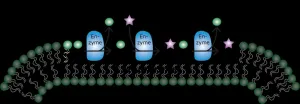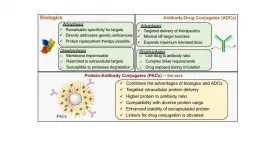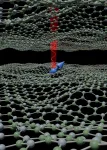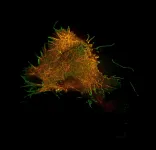(Press-News.org) Cells of all life forms are surrounded by a membrane that is made of phospholipids. One of these are the cardiolipins, which form a separate class due to their unique structure. When studying the enzyme that is responsible for producing cardiolipins in archaea (single-cell organisms that constitute a separate domain of life), biochemists at the University of Groningen made a surprising discovery. A single archaeal enzyme can produce a spectacular range of natural and non-natural cardiolipins, as well as other phospholipids. The results, which show potential for biotechnological applications, were published in the Journal of Biological Chemistry.
The phospholipids that are most abundant in cell membranes contain a hydrophilic head to which two hydrophobic tails are connected. Cardiolipins - so-called because they were first identified in heart cells - are slightly different since they are made up of a single head group that is attached to four lipid tails. 'We know which enzymes are responsible for cardiolipin production in bacteria and eukaryotes, but not in archaea,' says Marten Exterkate, who is the first author of the JBC paper.
Odd head group
His interest in these cardiolipins stems from his work on a synthetic minimal cell. 'Our group at the University of Groningen focuses on cell membrane growth, based on the enzymatic production of new phospholipids from basic building blocks.' Since cardiolipins are present in cell membranes of organisms from all domains of life, they are desired components of the synthetic cell. Exterkate wanted to know which enzymes are responsible for cardiolipin production in archaea. 'The lipids that form the cell membrane of archaea are structurally different from those in the other two domains of life,' Exterkate explains. 'Furthermore, while the other domains have one dominant type of cardiolipin, archaea appear to produce different kinds of cardiolipins, with head groups that contain, for example, only a single negative charge or different kinds of sugars or sulphate groups. Currently, we know next to nothing about how they are synthesized.'
By searching the genomes of archaeal species, Exterkate found several gene candidates for cardiolipin synthase. The most promising one from the archaea Methanospirillum hungatei was expressed in a standard laboratory strain of the E. coli bacterium, and the resulting enzyme was isolated and characterized. 'When we mixed the enzyme with potential building blocks, it produced the expected cardiolipin species. But then we noticed something really surprising: another cardiolipin with a very odd head group.' This turned out to be a molecule from the buffer solution in which the reaction took place.
Alarm bells
'All the alarm bells started ringing,' Exterkate recalls. 'If the enzyme can incorporate this buffer molecule as a lipid head group, what else could it do?' As it turned out, the enzyme was able to produce all kinds of variant cardiolipins and other phospholipids, containing both natural and non-natural head groups. 'Some enzymes are promiscuous; they can use slightly different variants of their normal substrates. But this enzyme is promiscuous in the extreme.' It can produce lipids that, in bacterial cells, for example, require many different enzymes.
This is the first identified enzyme with the ability to produce an entire range of different cardiolipins. Exterkate: 'Other archaea have similar genes, which are probably also suited to producing different cardiolipins, indicating that the variety in archaeal cardiolipins could be synthesized by the same enzyme.' Apart from being a surprising discovery, the new enzyme could be interesting for the production of self-designed membranes. This is useful because head groups in membrane phospholipids affect the overall properties of the membrane and the function of enzymes that are incorporated in it. 'The biotechnology industry could perhaps use this enzyme to artificially engineer membranes for specific purposes,' says Exterkate.
Osmoregulation
The discovery of this promiscuous enzyme also raises the question of why archaeal cells need all these different cardiolipins. So far, the textbooks refer to cardiolipins as one particular molecule. It is becoming clear, though, that cardiolipins form a class of molecules. Exterkate and his colleagues suspect that the enzyme is involved in osmoregulation. 'Depending on the environment, the enzyme can switch the production towards different phospholipids and in doing so, alter the functionality of the membrane.'
The enzyme could also turn out to be a bonus for the synthetic cell that Exterkate and his colleagues are working on. 'We planned to produce a membrane with a minimalistic phospholipid composition, so we wouldn't need to add lots of genes for different enzymes. Now, we can potentially produce lots of different phospholipids using only a single enzyme.'
Reference: Marten Exterkate, Niels A.W. de Kok, Ruben L.H. Andringa, Niels H.J. Wolbert, Adriaan J. Minnaard, Arnold J.M. Driessen: A promiscuous archaeal cardiolipin synthase enables construction of diverse natural and unnatural phospholipids. Journal of Biological Chemistry, first online as accepted 20 April
INFORMATION:
Lessons Learned from India's Polio Vaccination Program Provide Valuable Insights for Future Mass Vaccination Initiatives.
Toronto - As India urgently scales up its vaccination campaign for the COVID-19 virus, a new study which examined the country's successful program to eliminate polio provides guidance on how this and future mass immunization campaigns can be successful, especially in vaccinating hard to reach groups.
The study, conducted by students and faculty with the Reach Alliance, a research initiative based at the University of Toronto's Munk School of Global Affairs & Public Policy, says that medicine alone is insufficient for the elimination of disease.
The World Health Organization declared India polio-free in 2014. ...
AMHERST, Mass. - A team of researchers at the Center for Bioactive Delivery at the University of Massachusetts Amherst's Institute for Applied Life Sciences has engineered a nanoparticle that has the potential to revolutionize disease treatment, including for cancer. This new research, which appears today in Angewandte Chemie, combines two different approaches to more precisely and effectively deliver treatment to the specific cells affected by cancer.
Two of the most promising new treatments involve delivery of cancer-fighting drugs via biologics or antibody-drug conjugates (ADCs). Each has its own advantages and limitations. Biologics, such as protein-based ...
May 6, 2021 -- A significant level of symptoms of depression, anxiety and post-traumatic stress may follow COVID-19 independent of any previous psychiatric diagnoses, according to new research by Columbia University Mailman School of Public Health with colleagues at Universidade Municipal de São Caetano do Sul in Brazil. Exposure to increased symptomatic levels of COVID-19 may be associated with psychiatric symptoms after the acute phase of the disease. This is the largest study to evaluate depressive, anxiety, and post-traumatic stress symptoms in tandem among patients who had mild COVID-19 ...
Quantum computers or quantum sensors consist of materials that are completely different to their classic predecessors. These materials are faced with the challenge of combining contradicting properties that quantum technologies entail, as for example good accessibility of quantum bits with maximum shielding from environmental influences. In this regard, so-called two-dimensional materials, which only consist of a single layer of atoms, are particularly promising.
Researchers at the new Center for Applied Quantum Technologies and the 3rd Institute of Physics at the University of Stuttgart have now succeeded in identifying promising quantum bits in these materials. They were able to show that the quantum bits can be generated, read out and coherently controlled in a very ...
The Marburg virus, a relative of the Ebola virus, causes a serious, often-fatal hemorrhagic fever. Transmitted by the African fruit bat and by direct human-to-human contact, Marburg virus disease currently has no approved vaccine or antivirals to prevent or treat it.
A team of researchers is working to change that. In a new paper in the journal Antimicrobial Agents and Chemotherapy, investigators from Penn's School of Veterinary Medicine, working together with scientists from the Fox Chase Chemical Diversity Center and the Texas Biomedical Research Institute, report encouraging results from tests of an experimental ...
WASHINGTON -- Researchers have demonstrated a record-high laser pulse intensity of over 1023 W/cm2 using the petawatt laser at the Center for Relativistic Laser Science (CoReLS), Institute for Basic Science in the Republic of Korea. It took more than a decade to reach this laser intensity, which is ten times that reported by a team at the University of Michigan in 2004. These ultrahigh intensity light pulses will enable exploration of complex interactions between light and matter in ways not possible before.
The powerful laser can be used to examine phenomena believed to be responsible for ...
Recently, laser scientists at the Center for Relativistic Laser Science (CoReLS) within the Institute for Basic Science (IBS) in South Korea realized the unprecedented laser intensity of 1023 W/cm2. This has been a milestone that has been pursued for almost two decades by many laser institutes around the world.
An ultrahigh intensity laser is an important research tool in several fields of science, including those which explore novel physical phenomena occurring under extreme physical conditions. Since the demonstration of the 1022 W/cm2 intensity laser by a team at the ...
The health benefits of sardines and oily fish are widely known: their high levels of unsaturated fats help to regulate cholesterol levels and prevent the onset of cardiovascular diseases. However, the benefits don't end there. A study led by Diana Diaz Rizzolo, lecturer and researcher of the Universitat Oberta de Catalunya's (UOC) Faculty of Health Sciences and the August Pi i Sunyer Biomedical Research Institute (IDIBAPS), has discovered that the regular consumption of sardines helps to prevent the onset of type 2 diabetes. Nutrients found in high quantities in sardines - such as taurine, omega 3, calcium and vitamin D - help to protect against this disease which, according to CIBERDEM's Di@betes study, affects around 14% of the Spanish population over the ...
The published data provide additional detail of an initial analysis conducted in January, while more robust data from a complete analysis of the study was subsequently shared in March 2021.
Publication of initial primary analysis highlights cross-protection by the Novavax Covid-19 vaccine against the B.1.351 variant prevalent in South Africa during the study.
This is the first published study to show protection against mild Covid-19 caused by the B.1.351 variant circulating in South Africa.
An updated analysis of the study indicated 100% protection against severe Covid-19 due to the B.1.351 variant.
"An efficacy of 50% is sufficient to meet the World ...
UNIVERSITY PARK, Pa. -- Social media has become a platform for new mothers to openly share their experiences of the joys and challenges of parenthood. Researchers at Penn State and Dalhousie University have unraveled the sentiments in nursing mothers' tweets to better understand the factors influencing breastfeeding behaviors. They hope the findings can inform policies and interventions to support and improve resources for nursing mothers, such as breastfeeding support, workplace accommodations and technological aids such as apps.
"We are getting the raw sentiment of nursing mothers without putting them in a controlled experiment environment ...







